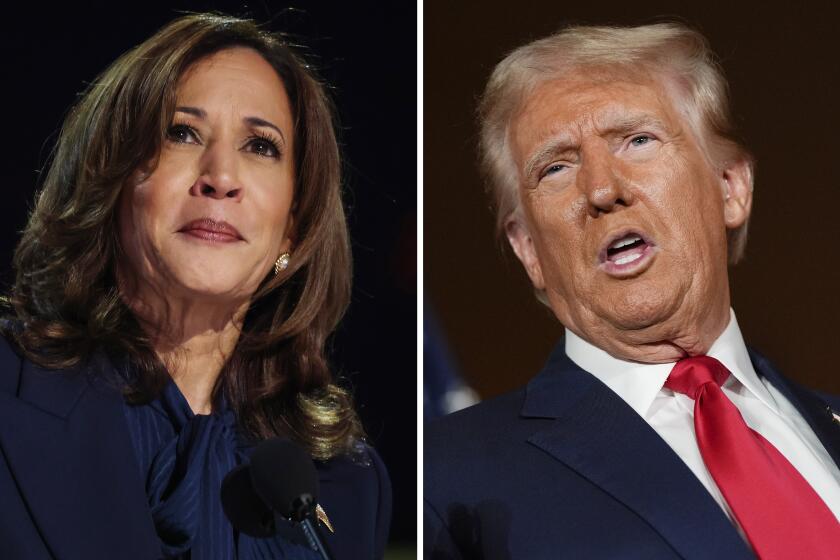Battle Over Farm Policy Forges New Alliances : Old Coalitions Shattered; Outlook for This Year’s Legislation Is Confounded
In years past, Ellen Haas, a consumer advocate, warred with the Reagan Administration over cuts in child nutrition programs. She battled the American Farm Bureau’s opposition to creating a federal consumer protection agency. She fought food processors’ efforts to loosen food safety laws.
But now, as the House begins voting on a wide-ranging farm bill this week, Haas’ consumer group--Public Voice--is linking arms with all of those erstwhile adversaries to oppose the legislation’s dairy, peanut and sugar programs. “Considering the past, it’s kind of an unholy alliance,” she conceded.
Haas’ marriage of convenience with her former adversaries is only one example of the way this year’s battle over farm policy is reshaping the traditional political landscape--and confounding the outlook for this year’s farm bill. So directly do the nation’s arcane agricultural programs now affect urban Americans, big business and the economy as a whole that an issue once dominated by a small, relatively unified farm lobby is now the subject of a fierce--and distinctly chaotic--legislative donnybrook.
Entrenched Alliances
In the old days, when farm bills went to the House and Senate floors, the shots were called by entrenched alliances among the general farmer organizations--the Farm Bureau, the National Farmers Union, the National Grange--and individual commodity groups such as wheat growers and milk producers.
This year, however, with economic depression battering much of the Farm Belt and runaway federal deficits forcing Congress to review its expensive 50-year-old policy of limiting agricultural production and propping up farm prices, the old coalitions have been shattered. Beyond that, agribusiness interests, rump farmer groups and consumer organizations are now contending as never before and, in place of the old alliances, there is a plethora of new alignments like Haas’.
“We all share an economic belief,” she said of the group she belongs to, that federally guaranteed price floors for farm products punish food buyers, crop exporters and taxpayers. “And we see an imbalance that needs to be changed. I think of this as a reform coalition.”
Untested in Battle
Inevitably, though, such newly minted partnerships are untested in battle. And their composition can change with each issue. The result is an enormously unstable outlook only days before the Sept. 30 expiration of the law that governs the nation’s agricultural programs, which vary from price supports to soil conservation to international food aid.
Unless new programs are enacted or current policy is temporarily extended, the law reverts to New Deal-era legislation that nearly all parties agree would be extraordinarily expensive and almost certainly unworkable. So the likelihood is growing that Congress will extend current policy for a brief period until it can find a consensus.
“It’s a mess. So many special interests have their finger in the pie, it’s very difficult to see where things lie,” said Michael Johnson, aide to House Minority Leader Robert H. Michel (R-Ill.).
Many Achilles’ Heels
Joseph Kinney, an agricultural consultant, agrees. “This legislation has so many Achilles’ heels, you would have to question whether Congress can pass any bill,” he said.
The farm debate significantly affects every American who eats and pays taxes, but it most directly concerns the nation’s 2.2 million farmers and the 23 million people in related agricultural businesses.
The debate, this year more than ever, centers on a simple but extremely perplexing question: To what extent should the government, instead of the marketplace, control commodity prices and provide income to farmers?
Ever since the Great Depression, the government has sought to stabilize farmers’ income and the nation’s food supply by regulating production and price levels for many commodities and by guaranteeing farmers an income through direct cash subsidies.
An Unprecedented Downer
The farm programs have had their ups and downs for both taxpayers and farmers, but the last four years have been an unprecedented downer--soaring government costs ($50 billion compared to an original $11-billion estimate), plunging commodity exports, mounting crop surpluses, sliding farm land values and escalating farm debt.
The basic problem is that the programs, by establishing a price floor for farm products, are encouraging overproduction and pricing American crops out of fast-growing world markets.
Last January, President Reagan proposed a dramatic policy shift--a phase-out of price supports and income subsidies that would subject commodities to the “free-market” forces of supply and demand. Although farm prices would fall, it was argued, farmers would ultimately be better off because they could sell vastly more products overseas.
Both the House and Senate Agriculture committees, concerned that moving too quickly in Reagan’s direction would unfairly drive many hard-pressed farmers out of business, are instead inclined to generally retain the framework of current programs while edging toward “market-oriented” prices.
Last-Minute Switch
But the House committee, in a last-minute switch before sending its bill to the House floor, proposed turning the huge wheat and corn programs sharply in the opposite direction--toward even greater government control. Momentum is also building for such a plan in the Senate, where the Agriculture Committee is still drafting its bill, because it promises to give panicked farmers at least a short-term income boost.
The House committee, stymied by farm groups’ conflicting demands, wrote a bizarre “multiple-choice” bill that offers no fewer than three options to curb runaway costs and surpluses in the government’s wheat and corn programs.
Farmers would vote in a national referendum on whether to institute a program entailing huge acreage reductions, sharply increased price supports and heavy export subsidies.
If farmers rejected that approach, Agriculture Secretary John R. Block would choose between two other options, both of which would reduce price supports but maintain farmers’ incomes by increasing the size of direct federal cash payments to them.
The farmer referendum proposal has significantly increased uncertainty over the bill’s prospects. It has unified some farm-state Democrats but alienated key Republicans and prompted a warning by Reagan that he would veto any measure that contained such a provision.
The referendum is being pushed by one of the new players on the lobbying scene--the American Agriculture Movement, representing “populist” farmers who staged the 1979 tractorcade in Washington to protest the farmer’s lot.
The idea is strenuously opposed by other newly active lobbyists representing agribusinesses, who protest that acreage cutbacks would cut their sales of seed, fertilizer, pesticides, tractors and other supplies. Fertilizer producers alone figure they lost $2 billion in sales to the Reagan Administration’s 1983 PIK (payments-in-kind) program, which gave government-stored surplus wheat to farmers who agreed to take fields out of production.
‘An Abrupt Change’
“No longer can we sit back and have such an abrupt change in farm policies,” said Gary Myers, president of the Fertilizer Institute.
As with the wheat and corn programs, the legislation’s dairy program faces an uncertain outcome because of a split in the traditionally unified dairy lobby. The National Milk Producers Federation, for years able to win enactment of programs to prop up milk prices and finance government purchases of surplus dairy products, is under uncustomary attack this year.
The House Agriculture Committee bill’s dairy provision, written with the help of the milk producers’ federation, would increase dairy price supports and, in an effort to reduce huge surpluses, pay some farmers to slaughter herds and cut milk production. The money for the payments would come from an assessment on all dairymen.
But a broad coalition including the Reagan Administration, a California-dominated group of large dairy farms, consumer groups, food companies that use dairy ingredients, supermarkets, restaurants and budget-minded groups such as the National Taxpayers Union and the U.S. Chamber of Commerce, is seriously challenging that approach. The self-styled reform coalition calls for lowering prices gradually over the next five years, by an estimated 18% for retail milk and cheese.
Gross Overproduction
“The dairy program encourages gross overproduction. It has cost the government close to $10 billion over the last five years,” said Richard Lyng, until recently a deputy secretary of agriculture and now a representative of the Dairy Farmers for Responsible Dairy Policy, a coalition group.
The uncertainty in Congress reflects not only the divided farm lobby but also extraneous pressures related to federal budget cuts and that eternal congressional imperative--reelection.
In the House, urban congressmen are reluctant to continue massive subsidies for farmers while mass transit, welfare and other programs are being cut for their own constituents. In the Senate, Democrats have coalesced around the notion that they can recapture control in next year’s elections by blaming Republicans for failing to stem the economic crisis on the farm.
Electoral politics figured prominently in the Senate Agriculture Committee’s approval of a new four-year farm bill that is $11 billion over the congressional budget limit of $34.8 billion.
GOP Holds Majority
Although Republicans hold a one-vote majority, the committee’s eight Democrats were able to pick up two Republicans and push through a costly income-protection plan for farmers even though it was vigorously opposed by Reagan, committee Chairman Jesse Helms (R-N.C.) and Senate Majority Leader Bob Dole (R-Kan.). One of the two Republican defectors, Sen. Mark Andrews (R-N.D.), faces a tough reelection race next year, while the other, Sen. Mitch McConnell (R-Ky.), was trying to build good will for a separate tobacco bill.
The committee adopted the Democratic-sponsored proposal for a four-year freeze of “target prices,” which provide farmers with federal subsidies when market prices for corn, wheat, cotton and rice are low. Reagan and GOP leaders want to save $2.7 billion by reducing the target prices--and the subsidies.
The full Senate will take up the bill next week.
California Rep. Leon E. Panetta (D-Monterey), who is observing the swirling farm bill fight from his perch on the House Agriculture Committee, marvels at how the usual alliances have come unglued as this year’s farm bill works its way through Congress.
Formerly, he noted, the old-line lobbying groups unified on the basis of supporting each other’s demands for ever higher price supports and subsidies. Now, he said, the groups recognize that they are grasping for slices of a shrinking pie, and they “are coming together merely on the basis of survival.”
More to Read
Get the L.A. Times Politics newsletter
Deeply reported insights into legislation, politics and policy from Sacramento, Washington and beyond. In your inbox three times per week.
You may occasionally receive promotional content from the Los Angeles Times.










